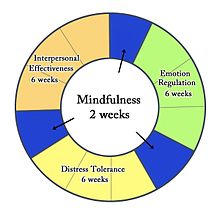Dialectical behavior therapy
Dialectical behavior therapy (DBT) is a form of psychotherapy developed by Marsha M. Linehan, a psychology researcher at the University of Washington. Linehan originally developed DBT to help people with borderline personality disorder (BPD).[1][2]

DBT uses cognitive-behavioral techniques to get patients to control their emotions and test what reality is. It also tests the patient's tolerance for distress, and tries to get them to accept their situation and be aware of their feelings.[3]
Linehan's ideas about how to be aware of your feelings come from Buddhist meditation. DBT may be the first therapy that has been shown to be effective in treating BPD.[4][5][6] It can also help patients with spectrum mood problems, including self-injury.[7] DBT may help victims of sexual abuse and people addicted to drugs.[8][9]
History
changeIn the early 1990s, Dr. Marsha Linehan developed an alternative therapy to treat her borderline personality disorder patients. Instead of having a one-way conversation with the patient, the therapist would engage him through the use of real world examples to elicit the desired responses. One by one, Linehan was able to teach her patients how to react differently in a variety of situations. This process removes the obstacles to treatment that had confused therapists treating suicidal patients. In a recent study, DBT has proven especially effective in reducing self-injurious behavior, suicide attempts and inpatient treatment days.
DBT has also been used to treat alcohol addiction[10] and drug addiction.
References
change- ↑ Janowsky, David S. (1999). Psychotherapy indications and outcomes. Washington, DC: American Psychiatric Press. pp. 100. ISBN 0-88048-761-5.
- ↑ Linehan, M. M. & Dimeff, L. (2001). Dialectical Behavior Therapy in a nutshell Archived 2017-07-13 at the Wayback Machine, The California Psychologist, 34, 10-13.
- ↑ "How DBT helps in drug de-addiction". American Addiction Centers. Retrieved 2020-11-14.
- ↑ Linehan, M. M.; Armstrong, H. E.; Suarez, A.; Allmon, D.; Heard, H. L. (1991). "Cognitive-behavioral treatment of chronically parasuicidal borderline patients". Archives of General Psychiatry. 48 (12): 1060–64. doi:10.1001/archpsyc.1991.01810360024003. PMID 1845222.
- ↑ Linehan, M. M.; Heard, H. L.; Armstrong, H. E. (1993). "Naturalistic follow-up of a behavioural treatment of chronically parasuicidal borderline patients". Archives of General Psychiatry. 50 (12): 971–974. doi:10.1001/archpsyc.1993.01820240055007. PMID 8250683.
- ↑ Kliem, S., Kröger, C. & Kossfelder, J. (2010). (2010). Dialectical behavior therapy for borderline personality disorder: A meta-analysis using mixed-effects modeling. Journal of Consulting and Clinical Psychology, 78, 936-951.[1]
- ↑ Brody, J. E. (2008, May 6). The growing wave of teenage self-harm. New York Times. Retrieved July 1, 2008.
- ↑ Decker, S.E.; Naugle, A.E. (2008). "DBT for Sexual Abuse Survivors: Current Status and Future Directions" (PDF). Journal of Behavior Analysis of Offender and Victim: Treatment and Prevention. 1 (4): 52–69.
- ↑ http://courses.washington.edu/chile08/Linehan4.pdf
- ↑ "Drugs or Alcohol Recovery - DBT". Sunrise House. Retrieved 2020-11-14.